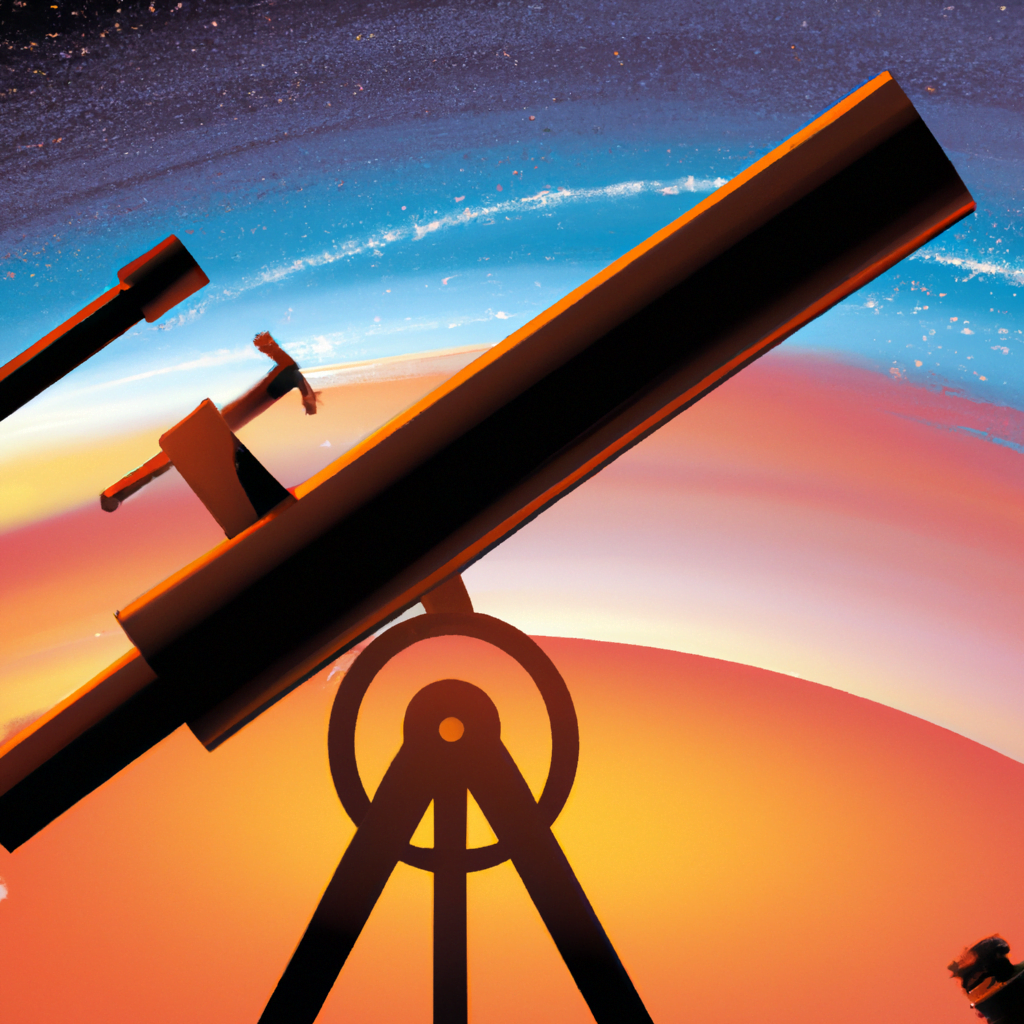Are you fascinated by astronomy and the wonders of the night sky? If so, you might have wondered about the Earth’s rotation and how it affects our observations. Understanding this key factor is crucial for accurately interpreting what we see in the heavens above. In this article, we will explore the significance of the Earth’s rotation during observations and uncover the ways it influences our perception of celestial objects. So grab a telescope, put on your stargazing hat, and let’s embark on a journey to unravel the mysteries of the Earth’s rotation in the captivating realm of astronomy.
Table of Contents
I. Understanding the Earth’s Rotation
A. What is the Earth’s rotation?
The rotation of the Earth refers to its spinning motion around its own axis. It takes approximately 24 hours for the Earth to complete one full rotation. This rotation is responsible for the occurrence of day and night as different parts of the Earth are exposed to sunlight at different times.
B. Why is it important to factor in the Earth’s rotation?
Factoring in the Earth’s rotation is crucial for accurate observations and measurements. The Earth’s rotation introduces various effects that need to be accounted for, such as the Coriolis effect and changes in the apparent position of moving objects. Failing to consider these effects can lead to errors and inaccuracies in scientific analyses and calculations.
C. How fast does the Earth rotate?
The Earth rotates at an average speed of approximately 1,040 miles per hour (1,670 kilometers per hour) at the equator. However, this rotational speed decreases as one moves towards the poles. At higher latitudes, the rotation speed diminishes to zero at the poles. It is important to keep in mind this variation in rotational speed when accounting for the Earth’s rotation during observations and measurements.
II. Implications of Earth’s Rotation on Observations
A. Coriolis Effect
The Coriolis effect is a notable consequence of the Earth’s rotation. It manifests as the deflection of moving objects, such as wind or ocean currents, due to the rotation of the Earth underneath them. This deflection occurs because different parts of the Earth’s surface are moving at different speeds. The Coriolis effect has a significant impact on weather patterns, ocean circulation, and projectile trajectories.
B. Apparent Deflection of Moving Objects
Another implication of the Earth’s rotation is the apparent deflection of moving objects. When an object is in motion, such as an airplane or a ballistic missile, its path appears to deviate due to the Earth’s rotation. This effect is most prominent over long distances and high speeds. To calculate the true trajectory of moving objects accurately, it is necessary to factor in the Earth’s rotation.
C. Changes in Time and Position
The Earth’s rotation also causes changes in time and position on a global scale. The concept of time zones is based on the Earth’s rotation, with each time zone representing a specific range of longitudes that experience the same time. Additionally, the rotational motion of the Earth affects navigational systems and the determination of latitude and longitude coordinates, requiring corrections to account for the Earth’s rotation.
D. Impact on Astronomical Observations
The Earth’s rotation significantly affects astronomical observations. As the Earth rotates, the position of celestial objects appears to shift in the sky over time. Observations of celestial bodies, such as stars, planets, and galaxies, must account for the Earth’s rotation to accurately measure their positions and track their movements. Failure to consider the Earth’s rotation can lead to errors in determining celestial coordinates and interpreting astronomical data.

III. Tools and Techniques for Factoring in Earth’s Rotation
A. Celestial Coordinate Systems
Celestial coordinate systems, such as the equatorial coordinate system and the horizontal coordinate system, are indispensable tools for factoring in the Earth’s rotation during observations. These systems provide a framework for precisely locating celestial objects by defining celestial coordinates based on the Earth’s rotation axis and its orbital plane around the Sun. By using these systems, astronomers can account for the Earth’s rotation when pinpointing the position of celestial objects.
B. Equatorial Mounts
Equatorial mounts are mechanical devices used in astronomy to align telescopes with the rotation of the Earth. By aligning the mount’s axis with the Earth’s rotation axis, astronomers can track celestial objects as they appear to move across the sky due to the Earth’s rotation. Equatorial mounts allow for smooth and accurate tracking of celestial objects, compensating for the Earth’s rotation and enabling longer observation times without the need for manual readjustment.
C. Star Trackers
Star trackers are sophisticated instruments commonly used in space-based observations. They utilize a combination of sensors and software to precisely determine their orientation relative to the stars. By continuously monitoring the positions of stars as the spacecraft rotates along its orbit, star trackers can account for the Earth’s rotation and maintain precise pointing accuracy. This ensures accurate data acquisition and imaging in space-based observations.
D. Gyroscopes
Gyroscopes are mechanical devices that utilize the principle of angular momentum to maintain stability and measure orientation. In terms of factoring in the Earth’s rotation, gyroscopes are used in navigation systems and instruments to detect and compensate for the Earth’s rotation. By measuring changes in angular velocity, gyroscopes can provide data that allows for adjustments to be made to account for the Earth’s rotation during observations.
IV. Calculating the Effects of Earth’s Rotation
A. Understanding the Rotation Rate
To accurately factor in the Earth’s rotation during observations, it is essential to have a clear understanding of the rotation rate. The Earth completes one rotation on its axis in approximately 24 hours, resulting in a rotational velocity that varies with latitude. By knowing this rotation rate, researchers and observers can calculate the necessary corrections required to account for the Earth’s rotation in their specific location.
B. Determining Latitude and Longitude Corrections
Factoring in the Earth’s rotation necessitates determining latitude and longitude corrections. The rotation of the Earth affects the determination of both latitude and longitude coordinates due to changes in position and time. Various mathematical formulas and algorithms are used to calculate these corrections accurately. By applying the appropriate corrections, accurate positional data can be obtained, enabling precise observations and measurements.
C. Compensating for the Coriolis Effect
Compensation for the Coriolis effect is crucial when factoring in the Earth’s rotation. The deflection caused by the Coriolis effect can significantly impact the trajectory of moving objects, such as aircraft or projectiles. To compensate for this effect, specific calculations or adjustments are made, depending on the application. By factoring in the Coriolis effect, more accurate predictions and calculations can be achieved in various fields, including meteorology and ballistics.
D. Adjusting Astrotracker Systems
Astrotracker systems, commonly used in astrophotography and astronomical observations, need to account for the Earth’s rotation to capture sharp and clear images. Most astrotrackers are equipped with motors that compensate for the Earth’s rotation by precisely rotating the camera or telescope in the opposite direction. These adjustments ensure that the tracked celestial objects remain stationary in the frame, resulting in well-focused and detailed images.

V. Considerations for Different Observational Scenarios
A. Land-Based Observations
Land-based observations require careful consideration of the Earth’s rotation. Depending on the location and duration of the observation, latitude and longitude corrections may need to be applied to ensure accurate results. For long-duration observations, equatorial mounts and tracking systems become vital, allowing for continuous tracking of celestial objects as the Earth rotates.
B. Airborne Observations
When conducting airborne observations, the Earth’s rotation can introduce additional challenges. The speed and altitude at which aircraft operate can amplify the impact of the Coriolis effect. Flight navigation systems need to account for this effect to ensure accurate course adjustments, especially during long-haul flights. Gyroscopes and advanced navigation instruments are utilized to factor in the Earth’s rotation and maintain precise positioning during airborne observations.
C. Space-Based Observations
Space-based observations are heavily reliant on factoring in the Earth’s rotation. Telescopes and satellites in space must carefully compensate for the Earth’s rotation to maintain consistent pointing accuracy. Star trackers, gyroscopes, and advanced control systems are utilized to account for the Earth’s rotation and ensure precise targeting of celestial objects. By effectively factoring in the Earth’s rotation, space-based observations can capture high-resolution images and collect accurate scientific data.
D. Oceanic Observations
Factoring in the Earth’s rotation is also important for oceanic observations, particularly in oceanography and marine navigation. The Coriolis effect plays a significant role in ocean currents and affects the transportation of heat and nutrients. Scientists and navigators must consider this effect when determining oceanic routes and studying ocean circulation patterns. Accurate calculations and adjustments contribute to better understanding and prediction of oceanic behavior.
VI. Challenges and Limitations
A. Atmospheric Conditions
One of the challenges when factoring in the Earth’s rotation is the variable and unpredictable nature of atmospheric conditions. Factors such as air density, wind patterns, and temperature inversions can affect the accuracy of observations. These atmospheric conditions make it necessary to develop sophisticated models and algorithms that account for these factors when calculating the effects of the Earth’s rotation.
B. Precision and Accuracy
Achieving high levels of precision and accuracy when factoring in the Earth’s rotation can be challenging. Small errors in calculations or slight variations in instruments can lead to significant discrepancies in observations and measurements. Continuous improvement in technology and calibration methods is necessary to minimize uncertainties and enhance the accuracy of accounting for the Earth’s rotation in various observational scenarios.
C. Practical Constraints
In certain situations, practical constraints can limit the ability to fully factor in the Earth’s rotation. For example, time constraints, limited resources, or technological limitations may restrict the application of advanced techniques and instruments. In such cases, approximation methods or simplified models may be necessary to estimate the effects of the Earth’s rotation, albeit with reduced accuracy.
D. Adjusting for Local Geographical Features
Factoring in the Earth’s rotation also requires considering local geographical features. Mountains, valleys, and other topographical characteristics can affect the rotation rate and introduce additional complexities in calculations. To account for these variations, advanced models and satellite measurements are used to obtain precise data on local geography, improving the accuracy of accounting for the Earth’s rotation.

VII. Case Studies and Examples
A. Astronomy and Telescopic Observations
In the field of astronomy, accurate accounting for the Earth’s rotation is crucial for various studies, such as tracking the movement of celestial objects, determining their orbits, and investigating transient phenomena like supernovae or solar flares. Telescopes equipped with equatorial mounts or advanced tracking systems enable astronomers to compensate for the Earth’s rotation and capture high-resolution images of distant galaxies, planets, and other astronomical objects.
B. Satellite Imaging
Satellites equipped with imaging systems heavily rely on factoring in the Earth’s rotation to acquire accurate and detailed images of the Earth’s surface. By precisely compensating for the Earth’s rotation, these satellites can capture images of specific targets or systematically monitor changes over time, contributing to applications ranging from climate studies to urban development planning.
C. Global Positioning System (GPS)
The Global Positioning System (GPS) relies on factoring in the Earth’s rotation to accurately determine position and navigation. GPS satellites, orbiting the Earth, take into account the Earth’s rotation to calculate precise positioning coordinates for receivers on the ground. By incorporating the Earth’s rotation, GPS provides users with accurate location information essential for various applications, including navigation, surveying, and geolocation-based services.
D. Geodetic Surveys
Geodetic surveys involve the measurement and mapping of the Earth’s surface. To achieve accurate results, these surveys must account for the Earth’s rotation. By implementing precise positional calculations, geodetic surveyors can effectively factor in the Earth’s rotation and generate accurate maps, monitor long-term changes in land features, or even detect tectonic plate movements.
VIII. Future Advances in Factoring Earth’s Rotation
A. Advanced Synchronization Techniques
Advancements in synchronization techniques can further enhance the accuracy of factoring in the Earth’s rotation. By developing highly precise timekeeping systems and improved synchronization algorithms, it becomes possible to account for the Earth’s rotation with greater precision, resulting in more reliable observations and measurements.
B. Adaptive Observation Systems
The development of adaptive observation systems holds promise for better factoring in the Earth’s rotation. These systems can dynamically adjust their parameters and configurations based on real-time data and environmental conditions. By continuously adapting to the Earth’s rotation, these systems offer enhanced accuracy and improved performance in diverse observational scenarios.
C. Earth Rotation Models
Continued refinement of Earth rotation models contributes to more accurate calculations of the Earth’s rotation effects. By incorporating more comprehensive data and advanced modeling techniques, scientists can refine existing rotation models and develop new ones that better represent the complex nature of the Earth’s rotation. These models enable more precise corrections and predictions in various scientific and practical applications.
D. Integration with Artificial Intelligence
The integration of artificial intelligence (AI) can revolutionize how the Earth’s rotation is factored into observations. AI algorithms can analyze large datasets, recognize patterns, and make predictive adjustments based on historical data. By leveraging AI, it becomes possible to optimize the accuracy and efficiency of factoring in the Earth’s rotation, leading to advancements in various fields, including astronomy, climate science, and navigation.

IX. Conclusion
A. Importance of Accounting for Earth’s Rotation
Accounting for the Earth’s rotation is of paramount importance in various scientific and practical pursuits. Failure to factor in the Earth’s rotation can result in errors, inaccuracies, and misleading interpretations. Considering the Earth’s rotation ensures the validity of observations, measurements, and calculations, contributing to the progress of multiple fields of study.
B. Continuing Research and Development
Continuing research and development efforts are crucial in advancing the understanding and techniques used to factor in the Earth’s rotation. Ongoing scientific investigations, technological innovations, and refinements of mathematical models allow for more accurate assessments of the Earth’s rotation effects. These efforts expand our knowledge and improve the tools and methods available for accurate observations and measurements.
C. Impacts on Various Fields of Study
The implications of factoring in the Earth’s rotation extend to numerous fields of study. Astronomy, meteorology, geodesy, navigation, and satellite imaging are just a few examples of disciplines where accurate accounting for the Earth’s rotation is essential for precise results and reliable data. The correct interpretation of observations and measurements significantly contributes to advancements and discoveries across these and other related disciplines.
D. Final Thoughts
Considering the Earth’s rotation during observations is a fundamental aspect of scientific research and practical applications. By factoring in the Earth’s rotation, scientists, astronomers, engineers, and various professionals can obtain accurate results, make informed decisions, and contribute to a deeper understanding of our planet and the universe. Through continuous learning, improvements in technology, and interdisciplinary collaborations, we can meet the challenges of factoring in the Earth’s rotation and unlock new opportunities for exploration and discovery.
